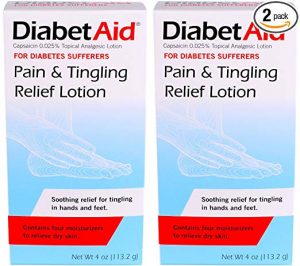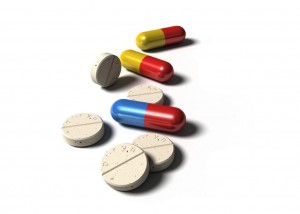Top 4 Diabetic Lotions to Help Increase Circulation.
Best Lotions for Diabetic Feet
Diabetes can cause deprivation of oxygen to your skin, leading to poor circulation that might lead to severe, chronic dryness, slow healing, redness, cracking, and itching. This basically means that diabetics can get injured more easily and are more likely to get infections that take longer to heal. Here are some of the best lotions for diabetic feet that can help alleviate these diabetes complications:
-
Neoteric Advanced Healing Cream
Neoteric advanced healing cream provides treatment for cracked, damaged, and chronic dry skin. One of its main ingredients is TriOxygenc which helps infuse oxygen into your skin. This diabetic skin care cream is proven to speed healing and increase circulation by strengthening the natural defenses of the skin. It provides instant soothing action by quickly restoring your skin to a healthier, smooth soft texture.
- Especially great for feet and hands
- Speeds healing by strengthening the natural defenses of the skin
- Protects and restores chronic dry, damaged, cracked skin
- Helps increase the skin’s natural collagen production and circulation
- Promotes, healthier, stronger, more resilient skin
- Provides therapeutic skin moisturization and protection
- Non-greasy
- Absorbs very easily
Neoteric advanced healing cream provides exceptional skin care for people with all types of dry skin conditions including diabetes.
How to use
Apply as often as necessary or as directed by the healthcare expert or physician. Daily use is recommended to help maintain the skin’s soft, healthy appearance.
-
Gold Bond Ultimate Hydrating Lotion – Diabetic Skin Care Lotions
With diabetes, your skin can become rough, cracked and uncomfortable. Gold bond ultimate hydrating lotion is specifically formulated for dry skin with hydralast and seven intensive moisturizers to hydrate and soothe the skin while adding a strong protective layer of moisture for up to 24 hours. Gold bond ultimate hydrating lotion is ideal for daily use and does not contain any harsh alpha hydroxyl acids that irritate the skin.
- Ideal for all over body use
- Contains aloe and essential vitamins that moisturize and nourish dry, flaky skin
- Keeps the skin feeling and looking noticeably healthy
- Hypoallergenic
- Fragrance-free
- An exclusive formula that is dermatologist tested
How to use
Apply Gold bond ultimate hydrating lotion liberally to rough, dry and problem skin areas to speed up moisturization.
-
Eucerin Diabetics’ Skin Relief Body Lotion
Eucerin diabetics’ dry skin relief lotion is specifically designed to leave the skin feeling comfortable, hydrated and healthier all day long. This unique, non-greasy formula is enriched with alpha hydroxyl which repairs and exfoliates dry, flaky skin. Besides smooth ing dry, rough skin, Eucerin diabetics’ skin relief body lotion noticeably improves overall skin condition and appearance just after one use! It is designed to repair, enhance and protect your skin, giving you the confidence that comes from healthy-looking and radiant skin.
- The alpha hydroxyl formula smoothens rough, dry skin after just one use
- Fast absorbing and lightweight
- Fragrance-free
- The clinically proven formula that provides 24-hour moisture
- Paraben-free
- Dermatologist recommended brand
How to use
Apply liberally over rough, dry skin every day or as recommended by the physician. Apply immediately after showering or bathing for best results.
-
DiabetAid Pain and Tingling Relief Lotion
Diabetes can cause two main problems that hurt your legs and feet. One complication is damage to the nerves which leads to an infection or a sore. The other problem is blood flow which can make it hard for an infection or sore to heal. However, if you check for sores, cuts and also for sand, wash your feet and hands with mild soap, chances of infections are greatly reduced. Sometimes you may also feel a tingling sensation in your hands and feet. Applying DiabetAid pain and Tingling Relief Lotion will relieve those uncomfortable sensations.
- Soothing relief for uncomfortable tingling in the feet and hands
- Contains 4 essential moisturizers to relieve dry, rough skin
- Does not contain any ingredients that are considered harmful or dangerous to diabetics.
How to use
Apply to affected areas daily but you should avoid applying more than 4 times per day. Children under 2 years should consult a doctor for directions and recommendations.
Learn everything you should know about Coronavirus and diabetes HERE!











 Whilst the idea of inhaled insulin has been around for several decades, researchers only made it possible in the 1990s. With inhalers much like the ones used by asthma patients, people with diabetes simply breathe a fine aerosolized insulin powder into the lungs where it is absorbed into the blood through blood vessels.
Whilst the idea of inhaled insulin has been around for several decades, researchers only made it possible in the 1990s. With inhalers much like the ones used by asthma patients, people with diabetes simply breathe a fine aerosolized insulin powder into the lungs where it is absorbed into the blood through blood vessels.
 Being a sodium- glucose co-transporter (SGLT2) inhibitor, Ertugliflozin works by increasing secretion of glucose in the urine.
Being a sodium- glucose co-transporter (SGLT2) inhibitor, Ertugliflozin works by increasing secretion of glucose in the urine.